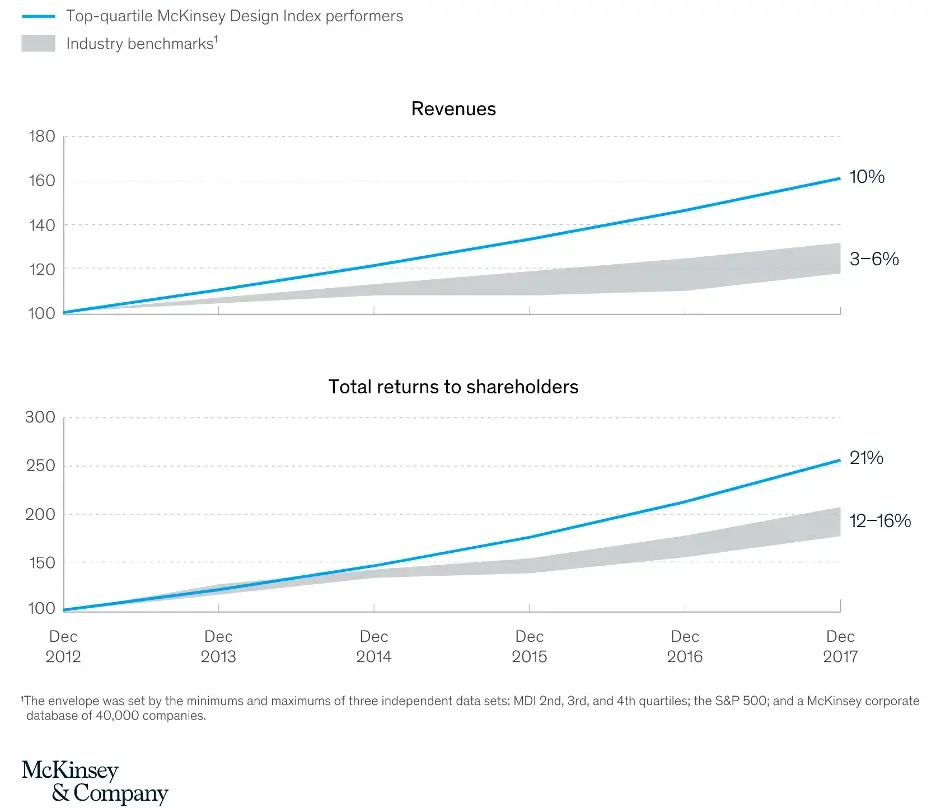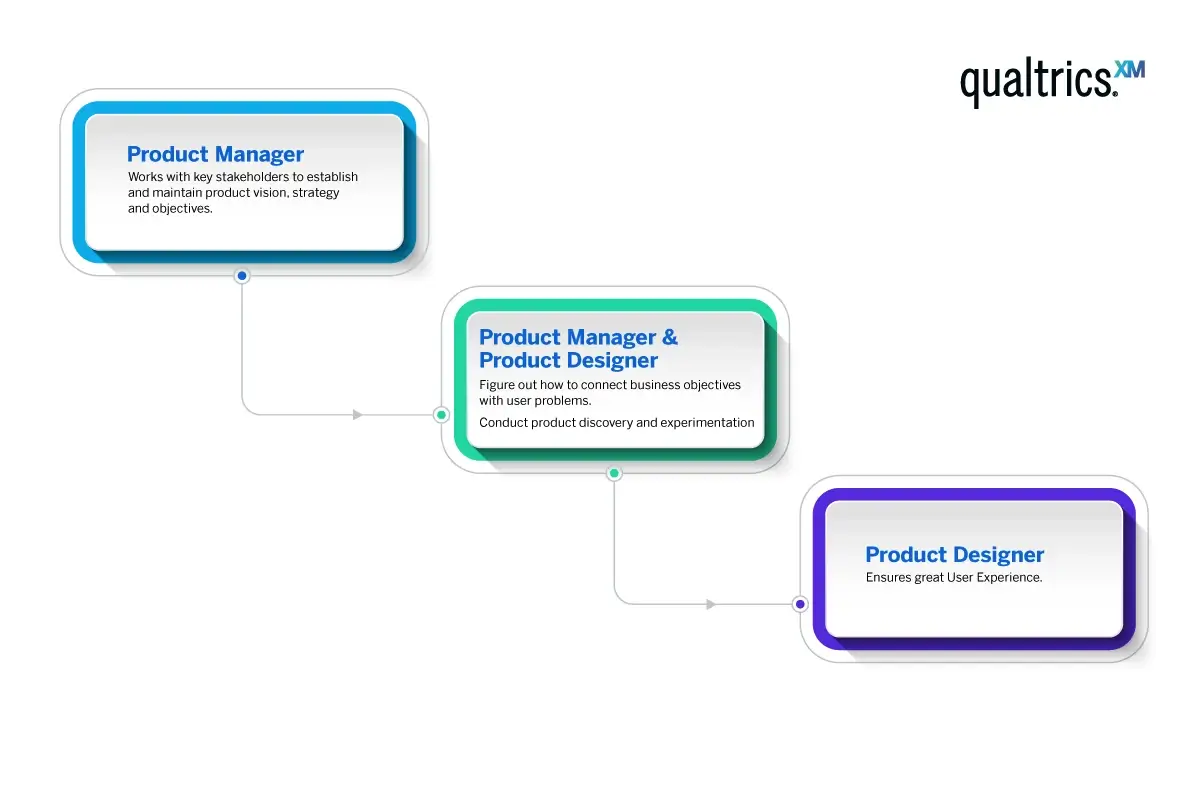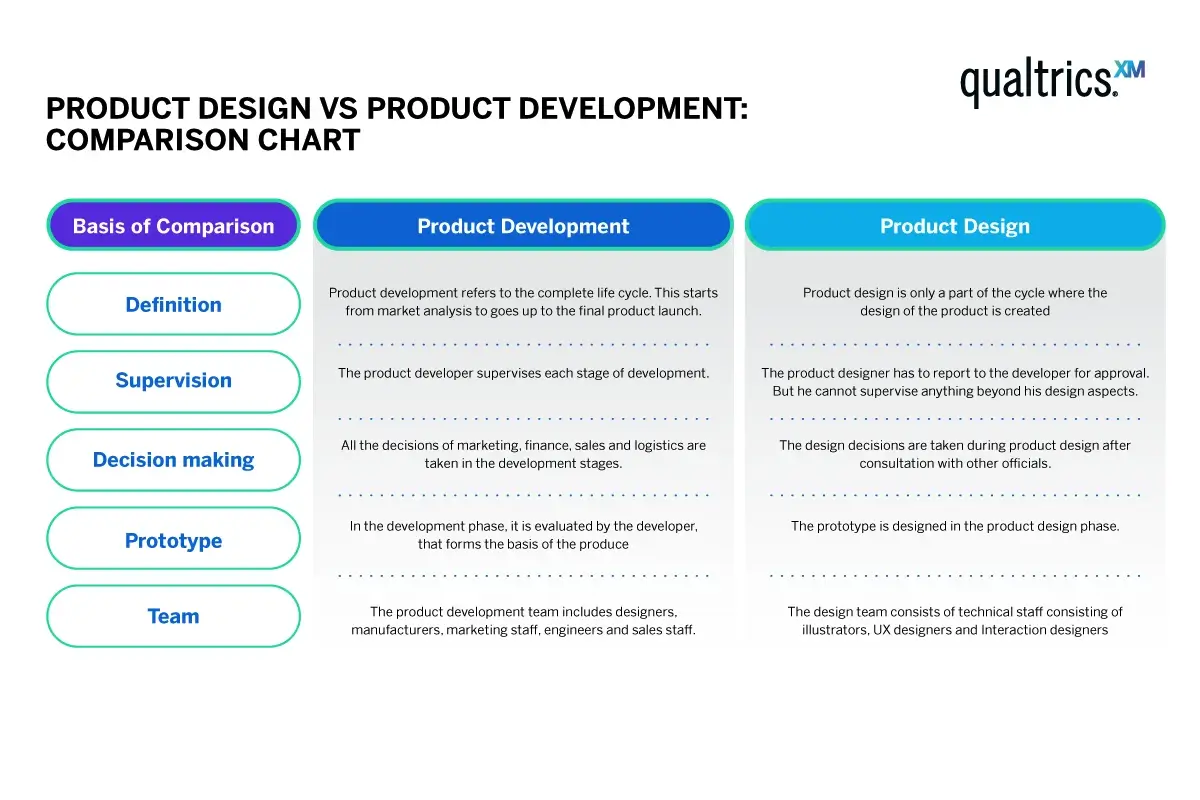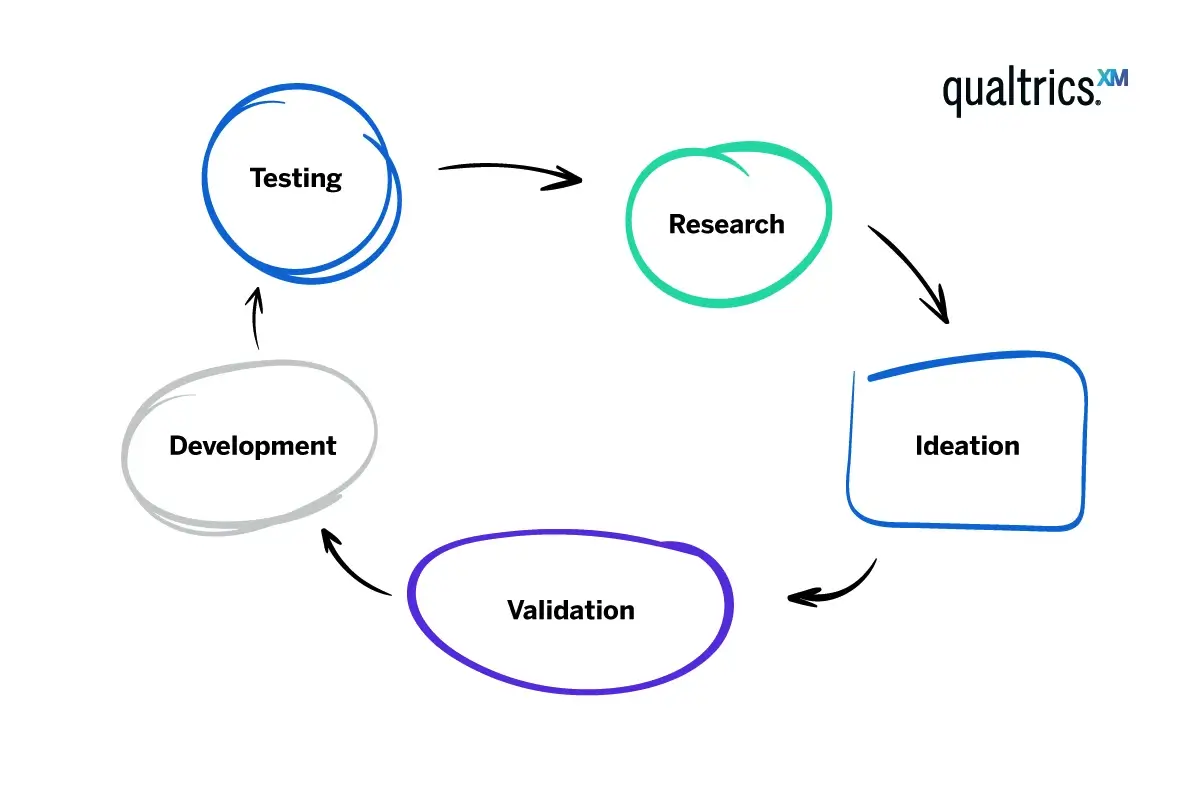What is product design?
Product design is the process of imagining, conceptualising, testing, iterating and refining a product, service or experience so it’s ready for its end user. Designers spend significant time on each of these steps, meaning that product design is a blend of research, strategy, industry knowledge and creative thinking.
What is the definition of a product?
In order to understand product design, it’s useful to define what we mean by a product.
Products can be physical things you can find on a shelf in a store, like a lightbulb or a bicycle, or they can be intangibles like software, services, experiences and even information, as with a training course or workshop.
The product is the end result of a product designer’s work – it’s what is offered to the customer at the delivery stage of the product design process.
Product design is a term that covers products, services and experiences of all kinds, whereas the more traditional term, industrial design, usually refers only to physical goods.
The product design process is shaped by user and business goals. A product’s success depends on how closely it lines up with user needs and how effectively it solves a user’s problems in the context of their life and work, since these factors will influence how well it sells and how profitable it is. It’s also influenced by the constraints of business, such as the budget available to develop it and the amount of time that can be dedicated to the design process.
For this reason, product design involves working closely both with people from within your business and from those in its target market, so you can make sure your product is on the right track all the way through its design journey.
How product experience research will drive growth
Why is product design important for your business?
We know on a personal level that great design makes the world a better place, and that poor designs can create stress and frustration. It’s often said that great design is invisible (a statement generally credited to designer Dieter Rams) because it creates frictionless experiences that barely interrupt a user’s task. But as a business, it’s reasonable to want to know how product design delivers return on investment, and what it’s doing for your business in the longer term.
McKinsey & Company set out to determine the relationship between design and business outcomes by developing the McKinsey Design Index. This in-depth project analyzed financial performance and design practices across 300 businesses. The findings show that businesses excelling in product design also deliver higher returns to shareholders and higher revenues compared with industry benchmarks.

The role of product designer
Product designers are the lynchpin of a company’s product design process. They are in charge of overseeing the design stage of the product development lifecycle. Product designers are tasked with working on brand new product designs and also with improving existing products.
A product designer’s role involves both creative and technical ability, and they are highly dependent on user research and user testing, some of which they might carry out themselves. Product designers typically have a strong grasp of multiple types of computer aided design (CAD) software and prototyping tools.
Product designers may work on digital products, services and experiences, or on physical products.
Product designers rarely work in isolation. As well as liaising with other parts of the business, they may collaborate closely with UX designers, visual designers, project management, UI designers, user researchers and professionals from other design occupations.
Product designer or product manager?
What’s the difference between a product designer and a product manager?
The exact specification for these roles might vary between different companies, but they are definitely not the same job. A product manager owns the product vision, which includes not only the product itself but the way it interacts with the market and the business objectives it serves. Product managers work across the entire product development process.
Product designers on the other hand are much more focused and specific. A product designer’s role is about making sure the product works as well as possible for its end users, that it’s functional and appealing. A product designer assists in project management across the entire design process, but likely won’t be involved in decisions like pricing, market positioning or messaging.
However, the product designer will work together with the product manager on finding the connections between user pain points and business goals, and finding solutions that address both sets of needs.

Product design and product development
As with the distinction between product managers and product designers, the difference between product design and product development is one of scope. Product design is about optimising the function of the product, service or experience and making sure it’s designed around a customer’s needs.
Product development is a much broader process that incorporates bringing products to market and managing them through the product lifecycle.

Product design – a pocket history
Product design has its roots in the related, but much longer-established discipline of industrial design.
Industrial design emerged when physical items were mass-produced for the first time. Whereas in the pre-industrial era, every craftsperson could design and refine their own products, when production became centralised and standardised, there was a need for a specific designer role.
Industrial designers were responsible for setting out the characteristics and features of the mass-produced items and making sure they were suitable for the markets in which they were sold.
Industrial design encompasses
- the utility of an item and how well it functions
- the features it includes
- its aesthetic and design characteristics.
Product design evolved from industrial design as part of a widening remit, away from simply physical products and into the broader category of products we defined earlier – both the physical and the intangible.
Product designers vs. UX designers
Product design is closely related to UX design, since both disciplines are based on iteratively shaping a solution around an end-user – a mode of working that’s known as Design Thinking.
So what sets UX designers and product designers apart?
It’s generally agreed that there are significant overlaps between the roles of product designer and UX designer. UX designers often work alongside product designers, and both roles involve high levels of user empathy, and both dedicate significant time and energy to understanding who the user is and where they are coming from.
The product designer role may have a wider remit than the UX designer, since it must take into account the aesthetics of a product and its alignment with the wider business brand, as well as its relationship to what competitors are doing in the same market.
UX designers generally have a broad theoretical knowledge of how humans interact with a design system and with the world around them, including aspects of psychology and cognitive theory. They may come from a range of backgrounds, whereas product design professionals often come from careers as visual designers.
What’s the typical product design process?

Today, product design is less an end-to-end process and more of a continuous lifecycle, since businesses are always reviewing and refining their products to make sure they continue to meet the needs of a changing customer base.
The steps in the product design cycle will vary from organisation to organisation, depending on what works best for individual teams and what kind of product is being developed. We can however generalise these basic steps:
1. Research
The first stage in product design is to thoroughly understand the end users and the business goals, in order to define the problem the product is to solve or the need it’s going to meet. This foundational stage of product design is where deep user empathy is required to develop a comprehensive understanding, which will underpin the rest of the design process.
The initial research phase might include:
- User research
Probably the most in-depth aspect of the research phase, user research involves the product designer gaining a deeper understanding of who the product’s users are, how users interact with similar products or services, and whether there are distinct user types within the pool of potential users.
Product designers might use user experience research methods like user interviews, survey questionnaires, and diary studies to gather user stories. They may work with UX designers or undertake the work themselves, depending on the business and the size of the project.
User feedback and usability testing remain important throughout the whole design process, but at this early stage the product designer and team are getting to know who the users are, creating a strong foundation for future work.
- Market research
Market research covers a broader remit, including not only the potential customers who will buy the product and the environments in which it will be sold and marketed, but also competitor analysis.
At this stage, a product designer might use primary and secondary market research data along with many other tools and resources to understand the business context of the product. It’s also when they’ll take a deep dive into the business requirements and goals for the product. This aspect of research connects the product designer’s role up with product managers and other professionals working within the product development lifecycle.
Although it’s understandable for a beginning product designer to be eager to get started developing ideas, it’s important not to rush this stage, as the quality and detail of the work you do at this point will have a big impact on the results later on.
At this stage, a product designer may want to generate a design brief. This is a statement of the user’s problem, including the context where it occurs, and the requirements that a product needs to meet in order to be an effective design solution.
2. Generate ideas
This is the part that probably comes to mind most intuitively when you think of product design.
The idea generation stage is where the creative thinking happens. Design ideas emerge and product designers come up with as many potential solutions as possible through techniques like brainstorming.
It’s often advised at this point that all ideas should be accepted into the list of possibilities with no judgment or bias applied to them. With a wide range of design concepts it’s more likely that one or two will make the journey through to becoming innovative products.
However, it’s not just a case of coming up with any and every possible idea. The idea generation stage is based on the discoveries during the user research stage, which will guide the process and help the product designer narrow down the possible options.
Product design ideas can be captured and communicated in a variety of ways. These might include sketching and drawing, mind-mapping, note-taking, computer-aided design or even creating physical models. Different ideas might focus on different aspects of a product, such as the user interface, the visual design, the colour palette, or the size and shape of a physical product.
3. Refine and validate design concepts
With a number of ideas created, product designers must refine their options and create concepts that are thoroughly checked against the user needs profile to make sure they’re viable for onward development.
They must also meet the business requirements, which may involve the aesthetic design, any potential overlap or integration with existing product lines, and whether it will be possible to realize the ideas within a set budget.
Potential ideas also need to be checked against required standards for function and performance, depending on the industry and product type.
The goal at this stage of product design is to make the journey from a great idea to an executable plan – not a detailed one maybe, but one that has the potential to be carried out.
Now is the time when the circle can be widened beyond the product design team and bring in stakeholders from elsewhere in the business to feed back on the concepts based on their specific expertise.
Concept testing is a key component of the refinement and validation stage. A concept-testing tool can help the product designer to gather feedback on many aspects of their ideas, from the features they’re planning to include to the style of the user interfaces.
They might also bring in research tools like conjoint analysis and Max Diff analysis to help define the right mix of features and functions for design concepts.
4. Prototype and test
At this stage of the design process, the ideas that have made the grade can be worked up into a prototype and tested further. In translating ideas into realities, any number of new considerations and challenges may appear, so there’s likely to be significant tweaking at this stage as the product designer creates prototypes.
Prototyping tools can be very helpful, especially for digital or service-based ideas. Paper prototypes are also popular among product designers, as they are quick and very cheap to execute and easy to understand and modify.
If the product is a physical one or is quite dependent on visual design, a designer may consider high fidelity prototypes. With these, it’s possible to carry out tests on attributes that weren’t apparent to the end user at the concept stage, such as texture or weight. The feedback gathered at this stage may be rich enough to justify developing more complex and expensive prototypes. In addition, creating high-fidelity prototypes will help designers explore production methods, prototyping tools and materials creatively.
Usability testing can help iron out issues with the UX design as early as possible, helping to save on wasted effort later in the product design process.
It’s worth noting that at this stage, an idea may yet turn out not to be viable. This is OK – product designers have a chance to go back to the start or pick up one of the other concepts that were developed in the previous stage.
5. Iterate
Each time the prototype is tested, new discoveries will come to light that can help improve the product. The iteration phases are when the improvements are made, and these phases sit in between the testing sessions.
How many iterations designers go through and how fast the cycle turns will depend on a few parameters, like the size of the design team, the extent of testing, the kind of testing, and how much budget is available.
6. Deliver
When the product has reached a viable state, it can be put out into the market. This doesn’t mean that research, testing and iteration grinds to a halt, however. These processes will continue to run in the background, maintaining the quality and performance of the final product over time.
How product experience research will drive growth